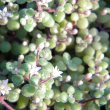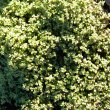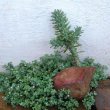| Botanical Name |
Crassula expansa subsp. fragilis |
| Family |
Crassulaceae - The crassula family. |
| Pronunciation |
KRASS-oo-la ek-SPAN-sa subsp. FRAJ-ih-liss |
| Common Name(s) |
|
| Plant Group |
- Ground Cover A plant with a low-growing, spreading habit, grown specifically to cover the ground.
- Succulent A plant having fleshy stems or leaves often adapted to dry conditions.
|
| Plant Size |
- Small
| Tree | 4m to 8m |
| Shrub | 50cm to 75cm |
| Perennial/ground cover | 10cm to 20cm |
| Bulb | 20cm to 30cm |
| Succulent | 10cm to 20cm |
|
| Position |
- Light or Dappled Shade Found below trees with sparse, open foliage. Ideal for the protection of herbaceous plants.
- Partial Shade The area is in shade for part of the day and in full sun for part of the day.
- Sun The area is in full sun for all or most of the day, all year round.
|
| General Information |
- Drought Tolerance: Moderate The plant is moderately adapted to arid conditions and can survive short periods of drought and high temperatures without extra water.
- Evergreen Plants that have leaves all year round.
- Evergreen to semi-deciduous The plant is evergreen in warmer, wetter parts of the country, but may lose some of its leaves during winter in colder, drier situations.
- Frost: Half-hardy The plant is able to survive low temperatures and some frost but requires protection against severe frost.
- Sand tolerant Plants adapted to survive in nutrient poor, very sandy soils.
- Water Moderate These plants will need some extra watering compared to water-wise plants. Plant them together, in at least some shade and in a convenient proximity to the house so that grey water can be utilised during times of drought.
|
| Specific Information |
Please Note: I found no information about this plant other than the botanical basics. Most of the content on this page comes entirely from my own experience with this plant, and should not be construed as authoritative comment. I have found this to be a remarkably resilient little plant, able to tolerate full sun and dry conditions, but with only a moderate tolerance to drought. It grows very well in light and partial shade, quickly spreading outwards to form rounded clumps of up to 40cm across. As with many ground hugging crassulas, it deteriorates soon after flowering and looks a bit dead, but this period does not last for much more than a month, after which it quickly re-establishes itself. I have also grown this plant in Johannesburg where it thrived if protected from frost. This plant is a winner for miniature gardens.
|
| Ad Break |
|
| Flowers |
| Description |
|
| Season |
- Summer Plants will seldom bloom for the entire season as given in the list, but should flower during a period within these parameters.
|
| Colour |
|
| Growth Rate |
- Fast Specifying growth rate can be very misleading as there is considerable variation of growth rate depending on type and species of plant, available water, supplementary feeding, mulching and general care, as well as the plants suitability and adaptability to the garden environment.
|
| Plant Uses |
- Attracts bees, butterflies or other insects This plant attracts insects which can be food for birds or other creatures in your garden.
- Container Trees, shrubs and ornamental species that can adapt to growing in a restricted environment.
- Edging A low growing plant that provides softness or definition to the edges of a bed or walkway.
- Filler Either a fast growing tree or shrub used temporarily to fill in an area while the permanent plants grow to a desired size, or a plant used to fill gaps in borders or beds.
- Foliage Plant Plants grown because their foliage is colorful or unique. Many of these plants have insignificant flowers.
- Ground Cover Low-lying plants that spread fast, require minimal maintenance, and cover large expanses or bare areas between bulbs or shrubs. They provide protection from erosion and drought and improve the visual appearance of the garden.
- Interplanting Arranging and planting plants in the garden that have different blooming times and habits of growth, extending the amount of time in which the area is in flower.
- Pot Plant A plant that needs a protected environment on a patio or indoors.
- Rock Garden An area constructed of larger rocks, arranged naturally, to emphasise the use of stones as a main element. Generally plants used do not need a lot of care.
- Suitable for coastal gardens Plants adapted to dry, sandy soil, forceful wind, limited rainfall and intense sunlight.
- Suitable for smaller gardens Such plants do not have invasive root systems, remain small or controllable and can often be grown in containers.
- Water Features These plants may have dramatic, lush foliage or graceful form. They do not shed excessive leaves and do not have invasive root systems.
|
| Distribution and Habitat |
in the provinces of the Eastern Cape, Gauteng, KwaZulu-Natal, Limpopo and Mpumalanga, north to Tanzania, and including Madagascar, in sandy soil in the shade of grass and small shrubs
|
| Planting Suggestions |
This little crassula thrives best if planted where it can have some shade, at least during the hottest part of the day. By positioning it under other plants or below a tree it is then also protected it from light frost. Good drainage is essential or the plant will rot, so clay is out but most soils will do. Thrives in shade with occasional watering and is remarkably useful around the garden to soften edges and fill open spots. The rooting system is very shallow and the clumps fall apart easily, leaving one to plant dozens of fragile stems with tiny roots. This is not fun. This is how I do it so both the plant and I get the most out of the experience. Keep the clump contained. It helps a lot to water the location the evening before. Check the soil and if it appears impoverished, mix a generous dose of organic matter into the soil before watering. Loosen the soil of the chosen spot and make a shallow depression about the same circumference as the plant clump. Place the clump in the depression and just snuggle the roots into the loose soil below, using only the fingertips. Tuck some soil under the outer edges and sprinkle some of the loose soil over the plant - not too much! Just enough to help anchor the roots. Of course bits of plant will always drop off. Press these into the loose soil around the mother plant. Water lightly to settle the soil without runoff. A thin layer of mulch can be scattered around the plant to conserve water, but too much mulch prevents it from spreading readily.
|
| Medicinal Uses |
|
| Ad Break |
|









Discuss this plant
Share knowledge, ask a question or give an experience.